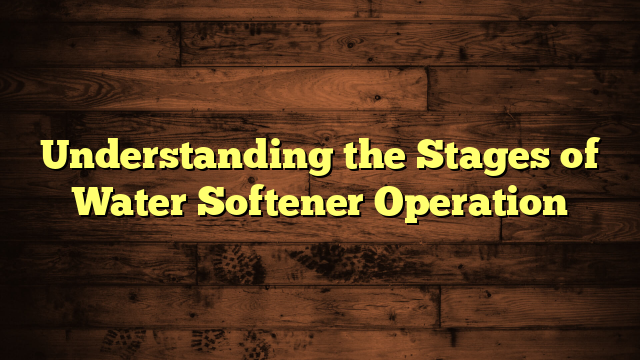How to Install a Water Softner in a House?
When you decide to install a water softener in your house, it's important to start with the right preparations. You'll want to turn off the main water supply and find a convenient spot for the unit, ideally near the main water line. Gathering the necessary tools, like an adjustable wrench and pipe fittings, is vital for a seamless installation. While the process may seem straightforward, there are specific steps and considerations that can greatly impact the final outcome. Let's explore those details to make sure your system operates efficiently for years to come.
Key Takeaways
- Assess your water hardness levels to choose the right type of water softener for your home.
- Gather essential tools, including an adjustable wrench, screwdrivers, and a tubing cutter for installation.
- Turn off the main water supply before making any connections to prevent leaks.
- Follow the manufacturer's instructions for installation, including applying Teflon tape to fittings.
- Develop a maintenance schedule to regularly check salt levels and inspect the system for optimal performance.
Understanding Water Hardness
Understanding water hardness is essential before installing a water softener. Water hardness is primarily caused by high levels of calcium and magnesium minerals, which can naturally occur in your water supply.
If you've ever noticed white scale buildup on your faucets or showerheads, you've likely experienced the effects of hard water firsthand.
These minerals don't just affect your fixtures; they can also have significant consequences for your appliances. For instance, dishwashers and washing machines often struggle with hard water, leading to decreased efficiency and increased wear and tear.
Over time, this can result in costly repairs or replacements. Moreover, hard water can make it harder for soaps and detergents to lather, meaning you might use more than necessary, which isn't just wasteful—it can also add up in expenses.
Choosing the Right Water Softener
When you're choosing the right water softener, you'll first want to assess your water hardness levels.
Understanding how hard your water is helps you select the appropriate type of softener that suits your needs.
With various softener types available, knowing what works best for your situation can make all the difference in enjoying softer water.
Water Hardness Levels
Water hardness levels play an essential role in choosing the right water softener for your home. Understanding your water quality starts with the hardness scale, which categorizes water as soft, moderately hard, hard, or very hard. You can typically measure hardness in grains per gallon (gpg) or parts per million (ppm).
For example, soft water has less than 1 gpg, while very hard water exceeds 10.5 gpg. Knowing where your water falls on this scale helps you select a system that effectively removes the minerals causing hardness, such as calcium and magnesium.
If you're dealing with hard water, it can lead to scale buildup in pipes and appliances, reducing efficiency and lifespan. Additionally, hard water can affect your skin and hair, making it feel dry and lifeless.
Once you know your hardness level, you can better assess the features you'll need in a water softener. Some systems are designed for higher hardness levels, while others are more suitable for light to moderate hardness.
Ultimately, understanding your water's hardness is the first step toward enjoying the benefits of a properly functioning water softener.
Softener Types Available
Choosing the right water softener can feel overwhelming with the variety of options available. You'll typically encounter two main types: salt-based systems and magnetic softeners.
Salt-based systems are the most common choice, using sodium ions to replace the hard minerals in your water. They're effective and can handle high levels of hardness, but they do require regular maintenance, including salt refills.
On the other hand, magnetic softeners are a newer option that claims to reduce hardness without using salt. They work by altering the physical properties of minerals in the water, making them less likely to form scale.
While they're low-maintenance and eco-friendly, their effectiveness can vary based on the specific water conditions in your home.
To decide which system is right for you, consider your water hardness level, maintenance preferences, and whether you want to keep sodium levels in check.
If you have severe hardness issues, a salt-based system might be your best bet. However, if you're looking for a more sustainable option, you might want to explore magnetic softeners.
Ultimately, understanding the pros and cons of each will help you make an informed choice.
Gathering Necessary Tools
Before diving into the installation of your water softener, it's essential to gather the necessary tools to guarantee a smooth process. Having the right tool types and essential items on hand can save you time and frustration. Here's a handy table to help you keep track of what you'll need:
| Tool Type | Essential Items | Purpose |
|---|---|---|
| Pipe Wrench | Adjustable Wrench | To tighten or loosen plumbing connections |
| Screwdriver | Phillips and Flathead | To secure mounting brackets and covers |
| Tubing Cutter | Plastic or Copper Cutter | To cut pipes for installation |
| Drill | Power Drill | For creating mounting holes |
| Level | Standard Level | To make sure your softener is installed evenly |
Gather these tools before you start, and you'll be well-prepared. This list covers the basics, but depending on your specific setup, you may need additional items. Don't forget to check your water softener's manual for any unique requirements. With everything ready, you'll be able to focus on the installation process rather than scrambling for tools. Happy installing!
Locating the Installation Site
When you're ready to install your water softener, the first step is finding the right spot.
You'll want to assess plumbing accessibility, identify drainage options, and consider space requirements to guarantee everything fits and works properly.
Taking the time to choose the ideal installation site will set you up for success in enjoying softened water.
Assess Plumbing Accessibility
To successfully install a water softener, you need to assess plumbing accessibility by carefully locating the installation site. This process involves understanding your home's plumbing layout and identifying any accessibility challenges you might face.
Start by evaluating the area where you plan to install the unit, guaranteeing it's close to your main water supply line.
Here are some key considerations:
- Proximity to Water Lines: The softener should be near both the main water supply and the drain for efficiency.
- Space Requirements: Guarantee there's enough room for the softener and for you to perform maintenance or repairs in the future.
- Access to Power Supply: Check that the installation site has easy access to an electrical outlet, as most softeners require power to operate.
Identify Drainage Options
As you pinpoint the ideal location for your water softener, identifying drainage options is vital for effective installation and operation. Proper drainage solutions will prevent water from pooling around your unit, which could lead to damage and inefficiency.
Start by checking your home's existing drainage systems. Ideally, you want a spot near a floor drain or a dedicated drain line that can handle the brine discharge from your softener.
Consider the installation requirements for your water softener, as some models may need a specific type of drainage setup. If your home doesn't have a nearby drain, you might need to install a sump pump or a dedicated drain line. This can add to your installation costs, so it's worth considering beforehand.
You should also avoid placing your water softener in a location where freezing temperatures might affect its operation. If you live in a colder climate, make sure your drainage area is insulated.
To summarize, assess your drainage options carefully, as they play a significant role in ensuring your water softener functions efficiently and lasts longer.
Consider Space Requirements
Proper drainage options are just one aspect of guaranteeing your water softener functions well; you also need to contemplate the space requirements for your installation site.
Effective space optimization can make a significant difference in your installation layout, making certain your water softener operates efficiently without crowding other utilities.
When choosing a location, consider these factors:
- Accessibility: Make sure you can easily reach the unit for maintenance and salt refills.
- Ventilation: A well-ventilated area can prevent moisture buildup, which is essential for the longevity of your system.
- Proximity to Water Supply: The closer your softener is to the main water line, the easier the installation and the better the performance.
Connecting the Plumbing
After gathering all your tools and materials, connecting the plumbing for your water softener is the next crucial step. Start by turning off the main water supply to your home. You'll need to determine where to make the water connections and use the appropriate pipe fittings to guarantee a secure fit.
Next, cut the pipe and attach the fittings as needed. You might require additional items like Teflon tape for leak prevention. Be sure to follow the manufacturer's instructions for the specific model you're installing.
Here's a handy table to help you understand the necessary components:
| Component | Description | Purpose |
|---|---|---|
| Pipe Fittings | Connects different pipes | Guarantees a secure connection |
| Water Connections | Points where water enters/exits | Directs water flow |
| Shut-off Valve | Controls water supply | Allows for easy maintenance |
Once you've made the connections, check for leaks by turning the water back on slowly. Tighten any fittings as necessary, and verify everything is in place before moving on to the next steps. This part of the installation is crucial for a successful water softener setup.
Setting Up the System
With the plumbing connected, you can now proceed to set up the system for your water softener.
Begin by placing the unit in a location that allows for easy access and maintenance. Make certain you have ample space around it for salt refills and cleaning.
Next, follow the manufacturer's installation tips to guarantee accuracy during the setup.
Start by programming the control panel according to your water usage. This will help the system enhance its efficiency based on your household needs. Remember to set the water hardness level correctly; this is essential for effective softening.
Here are a few additional tips to keep in mind:
- Check the salt level regularly: Maintaining an adequate salt level is important for peak performance.
- Position the bypass valve correctly: This allows you to bypass the softening process when necessary.
- Use clean, high-quality salt: It enhances the system's efficiency and lifespan.
Testing and Maintenance Tips
Regular testing and maintenance are key to keeping your water softener running smoothly. To guarantee peak performance, develop a maintenance schedule that includes regular inspections and refills of salt.
Check the salt levels monthly, and if they're low, replenish them to prevent your system from running inefficiently.
Water testing is another vital aspect of upkeep. Test your water every six months to monitor hardness levels and the presence of minerals like iron. You can purchase a simple water testing kit or send samples to a lab for more precise results.
If you notice any changes in water quality, adjust your softener settings accordingly.
Don't forget to clean your water softener periodically. You can do this by flushing the system with a vinegar solution or a specialized cleaner, following the manufacturer's recommendations. This will help prevent buildup and maintain your unit's efficiency.
Lastly, keep an eye out for any unusual noises or leaks, as these could indicate a problem.
Frequently Asked Questions
Can I Install a Water Softener Myself, or Should I Hire a Professional?
You can tackle a DIY installation if you're handy, but hiring professional services guarantees it's done correctly. Consider your skills, time, and comfort level before deciding which route works best for your water softener.
What Are the Signs That My Water Softener Needs Maintenance?
When your water softener starts acting up like a stubborn mule, check for signs like increased water hardness, salty taste, or a resin bed clogged with minerals. Regular maintenance tips can help keep it running smoothly.
How Often Should I Add Salt to the Water Softener?
You should check your water softener's salt level monthly. Depending on your water hardness and the type of salt you're using, you might need to add more salt every 4 to 6 weeks for peak performance.
Will a Water Softener Affect My Drinking Water Quality?
It's interesting how a softener can enhance your drinking water quality. You'll enjoy the benefits of softer water, which reduces scale buildup in appliances and pipes, ultimately improving the overall taste and safety of your water.
Can a Water Softener Remove Other Contaminants From My Water?
A water softener primarily targets hard minerals, so it won't effectively remove other contaminants. For thorough water quality improvement, consider additional filtration systems designed specifically for contaminant removal alongside your water softener.
Conclusion
By installing a water softener, you're not just improving your water; you're enhancing your home. You're protecting pipes from corrosion, extending the life of appliances, and enjoying softer skin and laundry. Remember to regularly check and maintain your system, ensuring it runs smoothly and effectively. With the right tools and a bit of patience, you've transformed your water quality and created a more comfortable living environment. So, take pride in your handy work and enjoy the benefits!







